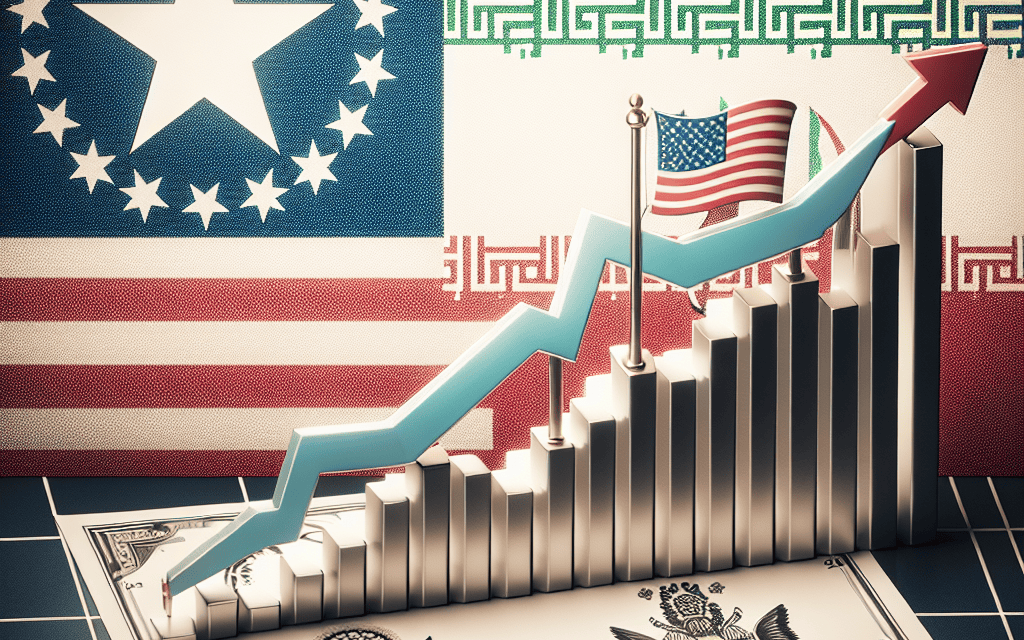“Global Markets on Edge: Oil Prices Soar as Israel-Iran Tensions Escalate”
Introduction
In recent weeks, global oil markets have experienced a significant surge in prices, driven by escalating tensions between Israel and Iran. The geopolitical friction between these two nations, both key players in the Middle East, has heightened concerns over potential disruptions in oil supply routes, particularly those critical to the global energy infrastructure. As diplomatic efforts to ease tensions have yet to yield substantial results, market analysts and investors are closely monitoring the situation, wary of further volatility. This surge in oil prices underscores the intricate link between geopolitical stability and energy markets, highlighting the broader economic implications of regional conflicts.
Impact Of Geopolitical Tensions On Global Oil Markets
The global oil markets have long been susceptible to fluctuations driven by geopolitical tensions, and the recent surge in oil prices amid escalating tensions between Israel and Iran is a testament to this enduring reality. As these two nations find themselves embroiled in a complex web of political and military confrontations, the ramifications extend far beyond their borders, reverberating through the global economy and impacting oil prices worldwide. This phenomenon underscores the intricate relationship between geopolitical stability and energy markets, highlighting the vulnerability of oil prices to international conflicts.
To understand the current surge in oil prices, it is essential to consider the strategic significance of the Middle East in the global oil supply chain. The region is home to some of the world’s largest oil reserves, and any disruption in its stability can have profound implications for oil production and distribution. The Strait of Hormuz, a critical chokepoint through which a significant portion of the world’s oil supply is transported, lies at the heart of this geopolitical tension. Any threat to the security of this vital passageway can trigger immediate concerns about supply disruptions, prompting traders to react swiftly and often preemptively, driving up oil prices.
Moreover, the ongoing tensions between Israel and Iran are not isolated incidents but rather part of a broader geopolitical landscape characterized by longstanding rivalries and alliances. The involvement of major global powers, each with vested interests in the region, further complicates the situation. As these powers navigate their diplomatic and military strategies, the uncertainty surrounding potential escalations or resolutions contributes to market volatility. Investors and analysts closely monitor these developments, adjusting their expectations and strategies in response to the evolving geopolitical climate.
In addition to the direct impact on oil prices, the tensions between Israel and Iran have broader economic implications. Rising oil prices can lead to increased costs for transportation and manufacturing, ultimately affecting consumer prices and inflation rates. This, in turn, can influence monetary policy decisions by central banks, as they strive to balance economic growth with inflation control. The interconnectedness of global economies means that the ripple effects of these tensions are felt far beyond the immediate region, affecting countries that rely heavily on oil imports and exports.
Furthermore, the current situation serves as a reminder of the ongoing challenges faced by efforts to transition to more sustainable energy sources. While geopolitical tensions underscore the volatility of oil markets, they also highlight the urgency of reducing dependence on fossil fuels. The pursuit of energy diversification and the development of renewable energy sources are crucial steps toward mitigating the impact of such geopolitical disruptions on global economies. However, the transition to a more sustainable energy future is a complex and long-term endeavor, requiring coordinated efforts from governments, industries, and consumers alike.
In conclusion, the surge in oil prices amid rising tensions between Israel and Iran exemplifies the profound impact of geopolitical dynamics on global oil markets. As these tensions continue to unfold, the world watches closely, aware of the potential economic consequences and the broader implications for energy security. The situation underscores the need for a multifaceted approach to addressing energy challenges, balancing immediate market responses with long-term strategies for sustainability and stability. As the global community navigates these complexities, the lessons learned from this episode will undoubtedly shape future approaches to managing the intricate interplay between geopolitics and energy markets.
Historical Context: Israel-Iran Relations And Oil Price Fluctuations
The intricate relationship between Israel and Iran has long been a focal point of geopolitical tension, with significant implications for global oil markets. Historically, the animosity between these two nations has roots that extend back to the Iranian Revolution of 1979, which marked a dramatic shift in Iran’s foreign policy and its stance towards Israel. Prior to this, Iran and Israel maintained relatively cordial relations, but the revolution ushered in a new era of hostility, with Iran adopting a more adversarial position. This shift has had profound implications not only for regional stability but also for global economic dynamics, particularly in the context of oil prices.
The Middle East, being a pivotal region for oil production, is highly sensitive to geopolitical tensions. Any escalation between Israel and Iran invariably sends ripples through the oil markets, often resulting in price surges. This is largely due to the strategic importance of the Strait of Hormuz, a critical chokepoint through which a significant portion of the world’s oil supply is transported. Any threat to the security of this passage, whether real or perceived, can lead to heightened concerns over supply disruptions, thereby driving up oil prices.
Throughout history, there have been numerous instances where tensions between Israel and Iran have coincided with fluctuations in oil prices. For example, during periods of heightened rhetoric or military posturing, markets have reacted with increased volatility. This is not merely a reflection of immediate supply concerns but also a manifestation of broader market anxieties about the potential for conflict to escalate into a wider regional confrontation. Such fears are not unfounded, given the complex web of alliances and enmities that characterize Middle Eastern geopolitics.
Moreover, the interplay between Israel-Iran relations and oil prices is further complicated by the involvement of other global powers. The United States, for instance, has historically played a significant role in the region, often aligning itself with Israel while imposing sanctions on Iran. These sanctions have targeted Iran’s oil exports, thereby reducing its ability to influence global oil supply. However, any shifts in U.S. policy, such as the lifting or intensification of sanctions, can have immediate repercussions on oil prices, underscoring the interconnectedness of geopolitical decisions and economic outcomes.
In recent times, the resurgence of tensions between Israel and Iran has once again brought the issue of oil price volatility to the forefront. As both nations engage in a war of words and military brinkmanship, markets are on edge, anticipating potential disruptions. The situation is further exacerbated by the broader context of global energy demand, which has been recovering in the wake of the COVID-19 pandemic. This recovery has already put upward pressure on oil prices, and any additional geopolitical instability could amplify these trends.
In conclusion, the historical context of Israel-Iran relations provides a crucial lens through which to understand the dynamics of oil price fluctuations. The interplay between geopolitical tensions and economic markets is a complex and multifaceted phenomenon, influenced by a myriad of factors ranging from regional alliances to global energy demands. As such, the ongoing tensions between Israel and Iran serve as a potent reminder of the delicate balance that underpins global oil markets, where political developments can have far-reaching economic consequences.
Strategies For Investors Amid Oil Price Volatility
The recent surge in oil prices, driven by escalating tensions between Israel and Iran, has created a challenging landscape for investors. As geopolitical uncertainties continue to influence the global oil market, investors are seeking strategies to navigate the volatility and protect their portfolios. Understanding the dynamics at play is crucial for making informed decisions in this unpredictable environment.
To begin with, the geopolitical tensions between Israel and Iran have historically had significant implications for oil prices. The Middle East is a critical region for oil production and any instability can lead to supply disruptions, causing prices to spike. Investors must remain vigilant, monitoring developments in the region closely, as these can have immediate and profound effects on the market. In such scenarios, diversification becomes a key strategy. By spreading investments across different asset classes, sectors, and geographies, investors can mitigate risks associated with oil price fluctuations. This approach not only helps in cushioning the impact of sudden price changes but also provides opportunities to capitalize on growth in other areas.
Moreover, considering investments in energy-related sectors beyond oil can be advantageous. Renewable energy, for instance, is gaining traction as the world shifts towards sustainable energy solutions. By investing in companies involved in solar, wind, or other renewable technologies, investors can potentially benefit from the long-term transition to cleaner energy sources. This strategy not only aligns with global trends but also offers a hedge against the volatility of traditional oil markets.
In addition to diversification, investors should also focus on maintaining a long-term perspective. While short-term fluctuations in oil prices can be unsettling, it is essential to remember that markets tend to stabilize over time. By adopting a long-term investment horizon, investors can avoid making impulsive decisions based on temporary market movements. This approach allows for a more measured response to volatility, reducing the likelihood of incurring losses due to panic selling.
Furthermore, staying informed about macroeconomic factors is crucial. Interest rates, inflation, and currency exchange rates can all influence oil prices and, consequently, investment returns. By keeping abreast of these factors, investors can better anticipate market trends and adjust their strategies accordingly. Engaging with financial advisors or utilizing analytical tools can provide valuable insights into how these elements interact with oil price dynamics.
Another strategy involves the use of hedging techniques to manage risk. Instruments such as futures contracts or options can be employed to protect against adverse price movements. While these financial instruments require a certain level of expertise, they can be effective in stabilizing returns during periods of heightened volatility. Investors should consider consulting with professionals to understand the potential benefits and risks associated with these strategies.
Finally, maintaining liquidity is essential in volatile markets. Having readily available cash reserves allows investors to take advantage of opportunities that may arise during periods of market instability. This flexibility can be particularly beneficial when oil prices are unpredictable, enabling investors to make strategic moves without being constrained by illiquid assets.
In conclusion, the surge in oil prices amid rising tensions between Israel and Iran underscores the importance of strategic planning for investors. By diversifying portfolios, focusing on long-term goals, staying informed about macroeconomic factors, employing hedging techniques, and maintaining liquidity, investors can navigate the challenges posed by oil price volatility. These strategies not only help in managing risks but also position investors to capitalize on potential opportunities in an ever-evolving market landscape.
The Role Of OPEC In Stabilizing Oil Prices During Conflicts

The recent surge in oil prices, driven by escalating tensions between Israel and Iran, has once again highlighted the critical role of the Organization of the Petroleum Exporting Countries (OPEC) in stabilizing global oil markets during periods of geopolitical conflict. As the world watches the unfolding situation in the Middle East, the importance of OPEC’s influence on oil prices becomes increasingly apparent. Historically, OPEC has played a pivotal role in managing oil supply to mitigate the impact of regional conflicts on global markets. This is particularly relevant in the current scenario, where the potential for disruption in oil supply chains looms large due to the strategic significance of the Middle East in global energy production.
In times of conflict, OPEC’s ability to adjust production levels is crucial in maintaining a balance between supply and demand. By coordinating production cuts or increases among member countries, OPEC can exert significant control over oil prices, thereby preventing extreme volatility that could destabilize economies worldwide. This capacity to influence market dynamics is especially vital when geopolitical tensions threaten to disrupt the steady flow of oil, as is the case with the current Israel-Iran situation. Moreover, OPEC’s role extends beyond mere production adjustments. The organization also serves as a platform for dialogue among oil-producing nations, fostering cooperation and consensus-building. This diplomatic function is essential in times of conflict, as it helps to prevent unilateral actions that could exacerbate market instability. By promoting collaboration, OPEC can help to ensure that member countries act in a manner that supports global economic stability, even amidst regional tensions.
Furthermore, OPEC’s efforts to stabilize oil prices are complemented by its engagement with non-member countries, particularly those involved in the OPEC+ alliance. This broader coalition, which includes major oil producers like Russia, enhances OPEC’s ability to influence global oil markets. Through coordinated actions with OPEC+, the organization can extend its stabilizing influence beyond its traditional membership, thereby reinforcing its capacity to manage the impact of geopolitical conflicts on oil prices. However, it is important to recognize that OPEC’s ability to stabilize oil prices is not without challenges. The organization must navigate complex political dynamics among its member countries, each with its own national interests and economic priorities. Achieving consensus on production adjustments can be a delicate process, particularly when member countries are directly involved in or affected by regional conflicts. Despite these challenges, OPEC’s track record demonstrates its resilience and adaptability in managing oil market stability.
In conclusion, as tensions between Israel and Iran continue to escalate, the role of OPEC in stabilizing oil prices becomes increasingly significant. Through its ability to adjust production levels, facilitate dialogue among member countries, and engage with non-member producers, OPEC plays a crucial role in mitigating the impact of geopolitical conflicts on global oil markets. While challenges remain, the organization’s efforts to maintain market stability are essential in ensuring that oil prices do not spiral out of control, thereby safeguarding global economic stability. As the situation in the Middle East unfolds, the world will undoubtedly continue to look to OPEC for leadership and guidance in navigating the complexities of the global oil market.
Economic Implications Of Rising Oil Prices On Consumer Goods
The recent surge in oil prices, driven by escalating tensions between Israel and Iran, has significant implications for the global economy, particularly in the realm of consumer goods. As geopolitical uncertainties loom large, the oil market has responded with volatility, leading to increased costs that ripple through various sectors. This development is not merely a regional concern but a global economic issue, as oil remains a critical component in the production and transportation of goods worldwide.
To understand the economic implications, it is essential to recognize the role of oil as a fundamental input in the manufacturing and distribution processes. When oil prices rise, the cost of production inevitably follows suit. This increase is often passed down the supply chain, ultimately reaching consumers in the form of higher prices for goods. For instance, industries heavily reliant on transportation, such as logistics and retail, face increased operational costs. These industries must either absorb the additional expenses, which can erode profit margins, or adjust their pricing strategies, thereby transferring the burden to consumers.
Moreover, the impact of rising oil prices extends beyond direct transportation costs. Many consumer goods, particularly those in the plastics and chemical sectors, are derived from petroleum-based products. As the cost of raw materials escalates, manufacturers are compelled to reassess their pricing models. This situation can lead to a cascading effect, where the price of everyday items, from packaging materials to household products, experiences an upward trajectory. Consequently, consumers may find themselves paying more for basic necessities, which can strain household budgets and reduce disposable income.
In addition to affecting consumer prices, the surge in oil prices can influence inflationary pressures within an economy. Central banks closely monitor inflation rates, as sustained increases can erode purchasing power and destabilize economic growth. In response to rising inflation, monetary authorities may consider tightening monetary policy by raising interest rates. While this approach aims to curb inflation, it can also lead to higher borrowing costs for businesses and consumers, potentially dampening economic activity and investment.
Furthermore, the broader economic landscape is also shaped by shifts in consumer behavior resulting from increased prices. As goods become more expensive, consumers may alter their spending habits, prioritizing essential items over discretionary purchases. This shift can have a profound impact on sectors such as retail and hospitality, which rely heavily on consumer spending. Businesses in these industries may need to adapt by offering promotions or diversifying their product offerings to maintain customer engagement.
In light of these challenges, companies are exploring strategies to mitigate the impact of rising oil prices. Some are investing in energy-efficient technologies and alternative energy sources to reduce their reliance on oil. Others are optimizing their supply chains to enhance efficiency and minimize costs. These efforts not only help businesses navigate the current economic climate but also contribute to long-term sustainability goals.
In conclusion, the surge in oil prices amid rising tensions between Israel and Iran presents a complex set of challenges for the global economy, particularly in the realm of consumer goods. As costs increase across various sectors, consumers and businesses alike must adapt to a changing economic environment. While the immediate effects are evident in higher prices and inflationary pressures, the long-term implications may drive innovation and efficiency as industries seek to navigate this volatile landscape.
Renewable Energy As A Buffer Against Oil Price Surges
The recent surge in oil prices, driven by escalating tensions between Israel and Iran, has once again highlighted the vulnerability of global energy markets to geopolitical instability. As these tensions threaten to disrupt oil supplies, the world is reminded of the critical need for alternative energy sources that can buffer against such price volatility. In this context, renewable energy emerges as a vital component of a more resilient and sustainable energy future.
The reliance on oil as a primary energy source has long been a double-edged sword. On one hand, it has fueled economic growth and development; on the other, it has exposed economies to the whims of geopolitical events. The current situation in the Middle East underscores this precarious balance. As oil prices climb, the economic repercussions are felt worldwide, affecting everything from transportation costs to the price of goods and services. This scenario underscores the urgency of diversifying energy portfolios to include more stable and sustainable sources.
Renewable energy, encompassing solar, wind, hydroelectric, and other sustainable technologies, offers a promising solution to this challenge. Unlike fossil fuels, renewables are not subject to the same geopolitical risks. They are abundant, widely distributed, and increasingly cost-competitive. As technology advances, the efficiency and affordability of renewable energy continue to improve, making it an attractive option for countries seeking to reduce their dependence on oil.
Moreover, the integration of renewable energy into national grids can enhance energy security. By reducing reliance on imported oil, countries can insulate themselves from external shocks and price fluctuations. This shift not only stabilizes energy costs but also contributes to a more predictable economic environment. In addition, the transition to renewables supports environmental goals by reducing greenhouse gas emissions and mitigating climate change impacts.
However, the transition to a renewable-based energy system is not without challenges. Infrastructure development, technological innovation, and policy support are crucial to overcoming barriers to widespread adoption. Governments play a pivotal role in facilitating this transition through incentives, subsidies, and regulatory frameworks that encourage investment in renewable technologies. Public and private sector collaboration is essential to drive research and development, scale up production, and integrate renewables into existing energy systems.
Furthermore, energy storage solutions, such as advanced batteries and grid management technologies, are critical to addressing the intermittent nature of some renewable sources. By ensuring a reliable and consistent energy supply, these innovations can further enhance the viability of renewables as a buffer against oil price surges.
In conclusion, the current geopolitical tensions between Israel and Iran serve as a stark reminder of the vulnerabilities inherent in a fossil fuel-dependent energy system. As oil prices surge, the case for renewable energy becomes increasingly compelling. By investing in and transitioning to renewable energy sources, countries can not only protect themselves from the economic impacts of oil price volatility but also contribute to a more sustainable and secure energy future. The path forward requires concerted efforts from governments, industries, and communities to embrace renewable energy as a cornerstone of a resilient global energy strategy.
Future Projections: How Long Will The Oil Price Surge Last?
The recent surge in oil prices has captured global attention, as escalating tensions between Israel and Iran have introduced a new layer of uncertainty to the already volatile energy markets. This geopolitical friction has led to concerns over potential disruptions in oil supply, particularly given the strategic importance of the Middle East in global energy production. As market analysts and policymakers grapple with the implications of these developments, the question on everyone’s mind is: how long will this surge in oil prices last?
To understand the potential duration of this price increase, it is essential to consider the underlying factors driving the current market dynamics. The Middle East remains a critical hub for oil production, with countries like Iran playing a significant role in the global supply chain. Any conflict or perceived threat in this region can lead to immediate market reactions, as traders anticipate possible supply disruptions. The recent tensions have heightened these fears, prompting a surge in oil prices as a precautionary measure against potential shortages.
Moreover, the global oil market is influenced by a complex interplay of supply and demand dynamics. On the supply side, OPEC and its allies, including Russia, have a significant impact on production levels. In recent months, these countries have been cautious in adjusting their output, aiming to balance market stability with their economic interests. However, the current geopolitical tensions could compel them to reassess their strategies, potentially leading to further fluctuations in oil prices.
On the demand side, the global economy is still recovering from the impacts of the COVID-19 pandemic. As countries continue to reopen and economic activities resume, the demand for oil is expected to rise. This increase in demand, coupled with potential supply constraints due to geopolitical tensions, could sustain higher oil prices in the short to medium term. However, it is important to note that the pace of economic recovery varies across regions, and any setbacks in this process could temper the demand for oil, thereby influencing price trends.
In addition to these factors, technological advancements and policy shifts towards renewable energy sources are gradually reshaping the energy landscape. While these changes are unlikely to have an immediate impact on oil prices, they represent a long-term trend that could alter the balance of supply and demand in the future. As countries invest more in sustainable energy solutions, the reliance on oil may decrease, potentially leading to a stabilization or even a decline in prices over the long term.
Furthermore, the role of financial markets cannot be overlooked in this context. Speculation and investor sentiment play a crucial role in determining oil prices, often amplifying the effects of geopolitical events. As tensions between Israel and Iran continue to unfold, market participants will closely monitor developments, adjusting their positions based on perceived risks and opportunities. This speculative activity can contribute to short-term volatility in oil prices, making it challenging to predict the exact duration of the current surge.
In conclusion, while the immediate future of oil prices is fraught with uncertainty due to the ongoing tensions between Israel and Iran, several factors will influence how long this surge lasts. The interplay of geopolitical developments, supply and demand dynamics, technological advancements, and market speculation will all play a role in shaping the trajectory of oil prices. As such, stakeholders must remain vigilant and adaptable, ready to respond to a rapidly changing energy landscape.
Q&A
1. **What is causing the recent surge in oil prices?**
Rising tensions between Israel and Iran have led to concerns about potential disruptions in oil supply, causing prices to surge.
2. **How do geopolitical tensions affect oil prices?**
Geopolitical tensions can lead to fears of supply disruptions, prompting traders to bid up prices as a precaution against potential shortages.
3. **What regions are most affected by the oil price surge?**
Regions heavily reliant on oil imports, such as Europe and parts of Asia, are most affected by the surge in oil prices.
4. **How might the tensions between Israel and Iran impact global oil markets?**
Prolonged tensions could lead to sustained higher prices and increased volatility in global oil markets, affecting economies worldwide.
5. **What role do speculators play in the oil price surge?**
Speculators may drive prices higher by betting on future supply disruptions, amplifying the effects of geopolitical tensions.
6. **Are there any potential solutions to stabilize oil prices amid these tensions?**
Diplomatic efforts to de-escalate tensions and increase oil production from other regions could help stabilize prices.
7. **What are the potential economic impacts of sustained high oil prices?**
Sustained high oil prices can lead to increased costs for transportation and goods, contributing to inflation and potentially slowing economic growth.
Conclusion
The recent surge in oil prices can be attributed to escalating tensions between Israel and Iran, which have heightened concerns over potential disruptions in the Middle East, a critical region for global oil supply. This geopolitical instability has led to increased market volatility, as traders and investors anticipate possible impacts on oil production and transportation routes. The situation underscores the vulnerability of global energy markets to regional conflicts and the importance of geopolitical factors in influencing oil prices. As tensions persist, the oil market is likely to remain sensitive to developments in the region, with potential implications for global economic stability and energy security.





